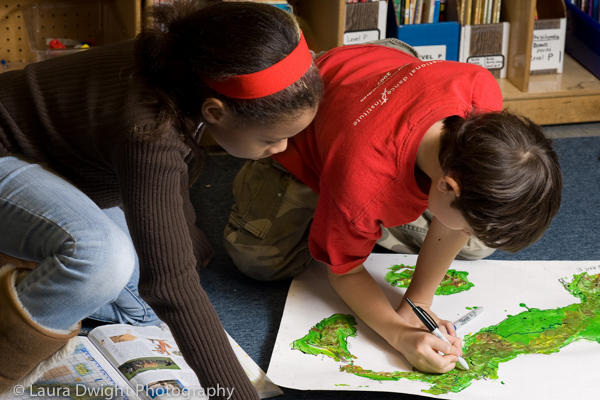
On A Quest for New Knowledge: Getting a Clearer Picture of Inquiry-Based Learning
Inquiry-based learning is sometimes misunderstood as a teaching practice, according to Dr. Sharon Friesen, Vice Dean, Werklund School of Education and President, Galileo Educational Network at the University of Calgary. But true inquiry is actually the discipline of thorough, in-depth investigation into a question, she says. It allows students to engage in authentic, real work that reflects the work an adult might tackle. It brings personal experience, the need for further information, knowledge creation, and deep understanding all into play.
Another misconception about the discipline is that it’s merely students making up their own questions as a way to learn about a topic. “In fact, that’s just part of it. It really becomes inquiry-based learning when students go through that process and then get to the really meaty questions that lead to the creation of new knowledge.”
Using the topic of “penguins” as an example, she says that too many teachers stop at the point when students have done what amounts to a lit review – a report on what’s already known. They go to the library and find books and various print and online publications to investigate the animals’ habitat and behavior. They draw conclusions and communicate their findings.
“That’s a good way to start,” Friesen says, “but it’s after those initial steps that you get into true inquiry: What are the unsolved problems, issues or questions around penguins? Is there anything at risk? What are the unresolved tensions? Is there encroachment on their territory? What are real scientists currently trying to find out about penguins?”
Teachers as Designers of Learning
And these questions often need to come from the teacher, especially for younger children, Friesen says. “In many cases teachers need to situate the problem for students, which requires that the teacher be deeply knowledgeable. They need to be able to guide students to which issues and questions merit inquiry.”
In this respect, inquiry-based learning is not a teaching practice, but a highly structured way of finding what is known, searching the contested spaces and defining the open problems. It’s a disciplined way of building knowledge and is treated with the same seriousness as scholarship at a university.
Assessment in Inquiry-Based Learning
Friesen says you don’t know what you set in motion by leading students to these questions. “Usually we underestimate young children because we only give them a rule instead of teaching them how to assess their own work,” she says. Part of inquiry-based learning is helping them see what the end target looks like at the beginning so that feedback and assessment are built into inquiry instead of coming at the end.
A video on the Galileo website shows how second graders came to understand the engineering principals that support boat design. Their end target was a boat that actually floats, and they could assess themselves on how well their creation performed by just setting it in a tub of water.
When children can self-assess in this way, they begin to learn the criteria necessary for good work, and with feedback from the teacher, they can see where something is missing and set to work filling it in.
Addressing Student Needs in a Knowledge-Based Society
Friesen says that “it’s a shame the way we’ve invited kids to this incredible feast of learning and they’ve ended up eating the pages.” In a knowledge-based society, where we’re awash in information, students need to learn how to transform information into knowledge, to create something valuable out of all the data. Their ability to learn is more important than how well they do at following rules.
Fourth graders at one school were assigned the task of tracking their home’s use of waste products like paper, metal cans and plastics in preparation for a presentation to the appropriate town or community groups responsible for sewage treatment in their area. The assignment did not spell out the steps they should take; rather, it laid out questions around the problem of waste and suggested resources for further investigation. (Click here to see how the assignment was presented.)
Students need teachers to help them “learn with understanding, and not just collect sets of facts and skills,” Friesen says. “But this is a very rewarding way to work: Teachers are able to unleash their students’ desire for learning.”
The Beginning of their Life’s Work
Friesen says inquiry-based learning helps students find their way to the true problems that exist in the world – the ones that are meaningful, relevant and worth pursuing. These are the kinds of problems that spark lifelong questions and guide students to the places where they find they can contribute.
“This is what creates intrinsic motivation for learning,” Friesen says. “Children find their place in the world – and the world finds a place in them. I’ve seen traces of what students became in the inquiries they undertook at a very young age.” At age six, one of her students asked, “When you’re watching people, do you wonder what they’re actually thinking?” Twenty-five years later he’s earned a PhD in neurological philosophy and is still pursuing that question.
About Sharon Friesen, Ph.D.:
Founding partner and President of Galileo Educational Network, at the University of Calgary in Calgary, Alberta and Vice Dean of the Faculty of Education, Friesen has also taught kindergarten, elementary, middle, high school and post-secondary students. She has co-authored three books, including Back to Basics of Teaching and Learning: Thinking the World Together, which won the 2004 AERA Division B Book Award. The recipient of numerous awards for both research and teaching practice, she has also assisted schools in assessing their technology requirements for enhancing teaching and learning environments.

